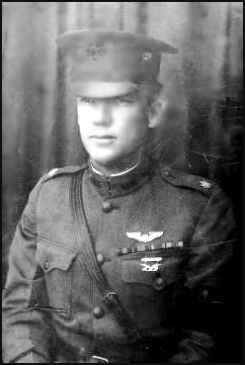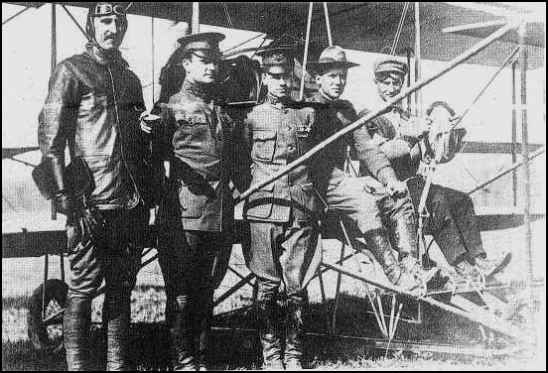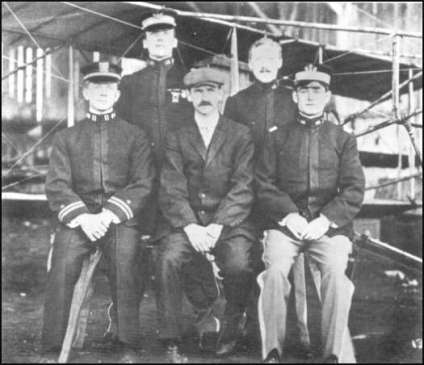
1876-1922 |
 |
|
|
 |
Army Lieutenants Leighton W. Hazelhurst Thomas Milling, and Paul Beck. At the control is Curtiss instructor Charles F. Walsh, civilian, who flew exhibitions in Nebraska before Worlod War I. (Courtesy of U.S. Air Force) |
Born 01 December 1876 (Texas) - Died 04 April 1922 (Oklahoma City, OK) Promoted to 1st Lt. 21 March 1901. * See Correction Below Graduated The Infantry School and The Cavalry School 1905. Graduated The Signal Corps School in 1906. On 04 February 1907 Assigned to Signal Corps as a 1st Lt. On 07 January 1911 was selected to attend the first aviation school in San Diego, California, taught by pioneer aviator Glenn Curtiss. He was promoted to Capt. on 11 March 1911. In January 1910 Beck conducted the first bombing experiment. (See Bomb Dropping Notes below) On 21 January 1911 1st Lt. Beck went up in an aircraft with a wireless telegraph set (Type A-4) which he designed and placed on his lap (weight 29 pounds), flew to an altitude of 500 feet and conducted the first radio telegraph transmission from an aircraft and was received over 40 miles away. |
|
Capt. Paul Beck qualified as a "Military Aviator" on 12 July 1912 (third of 25 pilots so qualified, the first being
1st Lt. H.H. (Hap) Arnold)
Later, Capt Beck flew a test air mail flight from Baltimore to Washinton D.C. with Postmaster General Wicksham as a passenger.
Capt. Beck was recalled to the Infantry from the Signal Corps Air Service and promoted to Major (temp.) on 5 August 1917. He was again promoted to Lt. Col. (temp) on 5 August 1918. On 28 August 1919 he was appointed Major (perm.) He transferred to the Army Air Srvice, and in January was promoted to Lt. Col. and assigned as Commanding Officer of the Henry Post Airfield at Ft. Sill, OK> Lt. Co. Paul W. Beck, while visitng Oklahoma City was shot and killed on 04 April 1922. NOTE: Paul Beck was the only officer/pilot to profess that the Signal Corps Air Service should be formed into its own corps service during the early years of Army Aviation. This vision came true with the formation of the U.S. Army Air Corps 1926. Is authored by William G. Schott, Las Vegas, NV (October 2004) |
|
via email from Dwight R. Messimer, 4-14-07 I just checked your website hoping that there might be more information on Paul Beck. I found an error that is minor, but you might want to correct it. In the website Beck's promotion to 1st Lieutenant is given as 21 March 1901. That isn't right according to his military records. Here is the sequence of events with the source citation after each entry: He went before a promotion board in Vigan, Luzon, the Phillipines on 12 March 1921. He was a 2nd lieutenant assigned to the 5th Infantry (Proceedings of a Board of Officers Convened at Vigan, Luzon, PI, 12 March 1901, Records Group 94, Records of the Adjutant General, National Archives). On 21 March 1901, the board found Beck qualified for promotion based on an overall score of 88.78%. The recommendation was approved in Manila that same day. (Proceedings of a Board of Officers Convened at Vigan, Luzon, PI, 3 May1901, Records Group 94, Records of the Adjutant General, National Archives). On 3 May 1901 the Adjutant General of the Army notified Beck that he was "therefore borne upon the records as qualified (emphasis mine) for promotion to the next higher grade." Beck was still a 2nd lieutenant when he received that notice. (Adjutant General's Office to 2nd Lt. Paul W. Beck, Letter, 3 May 1901, Records Group 94, Records of the Adjutant General, National Archives). On 30 June 1901 his commanding officer completed 2nd Lt. Paul W. Beck's Effeciency report for the period 30 June 1900 to 30 June 1901. The point is that on 30 June 1901 he was still a 2nd lieutenant. (Efficiency Report of 2nd Lt. Paul W. Beck, 5th Inf., 30 June 1901, Records Group 94, Records of the Adjutant General, National Archives). Finally, on 25 July 1902 he received a commission as a 1st lieutenant of infantry. (Adjutant General's Office to 1st Lt. Paul W. Beck, 25 July 1902, Records Group 94, Records of the Adjutant General, National Archives). On 8 September 1902 Beck signed his Oath of Office as a 1st lieutenant while still with the 5th Infantry in the Philippines. (Oath of Office, 8 September 1902, Records Group 94, Records of the Adjutant General, National Archives). I think the mistake comes from confusing his notice of qulification on 21 March 1901 with the actual promotion. Qualified meant just that--qualified. But he had to wait for an opening to be promoted, which happened sixteen months later. If anyone out there has the source citation for Paul Ward Beck, Jr's birth on 27 February 1897 and Paul W. Beck's marriage to Ruth Evelyn Everett in April 1898, I sure need it. The Best to you. Dwight R. Messimer Editor's Note: I thank Dwight for this correction and comprehensive update. If you can help to answer his questions, I will be happy to forward your message to him. |
 |
|
The first Military Aviation School in the United States opened on North Island January 17, 1911. Instructor, Glenn Curtiss, center. Students, left to right: Lieutenant T. G. Ellyson, Navy; First Lieutenant Paul W. Beck, Army; Second Lieutenant G. E. M. Kelly, Army; Second Lieutenant John C. Walker Jr., Army. The History of North Island, San Diego, California By Elretta Sudsbury |
|
Thank you, Bill Schott. |
|
Tennessee Journal and Tribune, Knoxville, Tennessee: April, 1910, Transcribed by Bob Davis - 3-31-04 Three separate portraits of Lieutenants Paul W. Beck, George M. Kelly, and John C. Walker, Jr. Bob Davis |
|
THE 1913 MILITARY AVIATOR' BADGE AWARDED TO CAPTAIN PAUL W. BECK, U.S. INFANTRY. by Walter Schott Army airplanes were considered experimental from 1909 to 1914. In March of 1912 the Secretary of War established regulations provididng for physical fitness examination and flight testing to qualiry "pilots" for rating as Military Aviators. Upon meeting the Qualifications, a 'certificate' was awarded to those aviators, stating they were "rated" as Military Aviator, however this certificate was not authorized until 1913. To read the whole fascinating story, just click on: |
|
Info from Dwight R. Messimer, 3-13-05 During the August 1913 Congressional Hearings on HR5304, Beck told the Congressional Committee that he and Crissy had collaborated on a bomb dropping device, but Crissy hotly denied that he and Beck had worked together at any time. The aviation journals and newspapers that covered the 1911 made no mention of any such collaboration, reporting only that Crissy had dropped "live bombs of his own design," and Paul Beck made the first airborne radio transmission. |
|
Info from Dwight R. Messimer, 3-13-05 Beck was a complicated and controversial figure during his initial, 15-month, aviation career, January 1911-May 1912. He was either a farsighted prophet or a self-aggrandizing manipulator, and was probably a little bit of both. His behind the scenes politicking in 1912-1913 earned him the wrath of two CSOs, Allen and Scriven, as well two Chiefs of the Signal Corps Aviation Section, Russell and Reber. He created so many powerful enemies in the Signal Corps that his transfer back to the infantry under the so-called Manchu Law [Art. IV, Par. 40, AR 1910] effectively ended his aviation career until he returned to aviation on 9 August 1920.. |
|
|
|
BY E. E. ENNIS Journal of Electricity, Power and Gas, April 1, 1911, pages 279-280: |
|
WIRELESS BEGINS TO TALK -- AND FLY Electronics in the West: The First Fifty Years, Jane Morgan, 1967, pages 32-38: |
|
via email from Dwight R. Messimer, 12-11-04 I'm a retired college professor currently working on a book about Army aviation, 1908-1917. I'm interested in the separation effort that occurred from April 1912 to October 1915. As you know, Capt. Paul Beck led the charge to separate Army aviation from the Signal Corps in 1912-1913. Though he was eliminated from the scene in 1913, I need more detailed biographical information on him, particularly how he was killed in Oklahoma City. Can you provide me with the details of his death? Editor's Note: See the article below the "In Memorium" section. Dwight has found the answer to this question. I have ample material dealing with his separation campaign, but my information on Beck is sketchy and sometimes confusing. One point that confuses me is the arm to which he was actually assigned from 1907-1912. The information I have is that he was on detached duty from the infantry to the Signal Corps for assignment at Benecia Barracks, California. I don't know exactly when that assignment was made, but it had to have been sometime before 1 May 1908. It was during his tour at Benecia that he attended the 1910 Los Angeles Air Meet, and the 1911 Tanforan [San Francisco] Air Meet as he was en route to the Curtiss school at North Island [San Diego]. According to Signal Corps records in Records Group 111 in the National Archives, he was returned to the infantry on 1 May 1912 under the so-called Manchu Law which limited detached duty from the line to four years in six. Under the existing Army Regulation [Article VI, Para. 39 and 40, AR1910], had he been a Signal Corps officer, he would have been exempt from the Manchu law. Yet Chandler, Lahm, and Foulois thought he was a Signal Corps officer. The fact is however, that he returned to the infantry in 1912 and remained there until after WWI. I saw your web posting regarding Beck, which has been very useful. So, I'm hoping that you can help me fill in some other missing parts. I look forward to hearing from you. Dwight R. Messimer Editor's Note: If you can help Dwight with his search for more details of the life and career of Beck, please contact me and I will forward your message to him. |
|
You will find a brief mention of Paul Beck dropping sandbags at the Los Angeles Flying Meet. on the "Up From Kittyhawk" page of the Air Force Association website To read the whole story, just click on: Paul Beck You may want to use your "Find" tool on "Beck." |
|
AIR SERVICE CAREER 1920-1922 Reassigned to Air Service from the Infantry 9 August 1920 30 September 1920 to 31 March 1921 JMA pilot training at Carlstrom Field, FL. 14 April 1921 He took command at Post Field. August 1921 his wife, Ruth, died 4 April 1922: Beck was murdered in Oklahoma City at Age 45. Judge Day's account: The Judge returned forty minutes later, and looking through the front window into the living room, saw Beck assaulting his wife. [At the Coroner's Inquest, Judge Day described the scene as "they were embracing." Beck jumped to his feet as the Judge entered the living room. Without saying a word, Judge crossed the room to the stairway, and went up. He returned to the landing facing the living room with a pistol in his hand. Judge Day paused on the landing, saw no sign of Beck, and went into the kitchen to make a circuit of the lower floor. He was walking through the breakfast nook and into the dining room when he saw the portieres decorating the entrance to drawing room bunched, apparently hiding a man's figure. When Day was four feet away, Beck stepped out. Day saw Beck draw back his right arm as though to strike, and Day stepped in and brought the gun down onto Beck's head. Judge Day claimed that he and Beck were were facing each other when he struck Beck on the head with the pistol barrel, and the gun discharged. ["Lawton Friends Sure Full Story Will Vindicate Beck: Is All Told? Hughes Asks," Daily Oklahoman, 7 April 1922, p.1] Sheriff Ben Dancy said that Beck was shot in the back of the head. ["Was Beck Shot From Behind?" [Daily Oklahoman, 7 April 1922, p.1] County Attorney Hughes, who was considering filing a murder charge against Judge Day, ordered a Coroner's Inquest. The issue was Judge Day's claim that he was facing Beck when the gun fired. The Judge's claim was shown to be false by the coroner's drawing which showed that the bullet entered Beck's head at the rear of the skull on the right side, and traveled directly into the middle of the brain. A fragment broke off and impacted the inside of the skull on the left side near the left eye, fracturing the skull at that point. ["Was Beck Shot From Behind?" Daily Oklahoman, 7 April 1922, p.1] Day and his first wife divorced soon after the slaying. Maj. Thomas George Lamphier Capt. Vernon L. Burge Capt. Roger McCullough The Army Board raised several questions, among which were: Why was Judge Day so insistent on driving guests home who lived less than a block away? If Judge Day intended only to strike Beck, why did he get his pistol? If Judge Day intended to use the pistol to strike Beck, why did he strike him with the barrel and not with the butt? In their report to War Department the Army Board included a letter that a woman who attended the party had written to Paul W. Beck, Jr. According to the letter, alcohol played a larger role during the party than was reported at the Coroner's Inquest, but, she wrote, "Lieutenant Colonel Beck was sober throughout the evening." ["Army Board Files Report in Day Case," Daily Oklahoman, 29 April 1922] You can draw your own account of what actually took place, but the outcome will be the same--Judge Jean P. Day murdered Paul Beck in the early morning hours of 4 April 1922 in Oklahoma City. |
|
If you have any information on this Early Bird, please contact me. E-mail to Ralph Cooper Back 

|